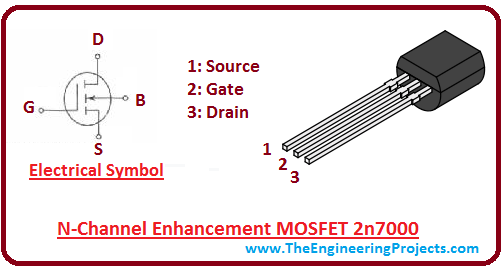

Introduction to 2n7000


Introduction to 2n7000
- 2n7000 is a uni-polar N-Channel Enhancement mode MOSFET which comes with terminals called drain source and gate.
- In this transistor, the input voltage applied at the gate terminal is used to control the conductivity between source and drain.
- The conducting path between source and drain is called channel whose length can be controlled by the input voltage at the gate terminal.

- As it is an enhancement mode MOSFET, it is assumed as OFF i.e. it doesn't conduct under normal operating condition when Vgs=0. It will start conducting when some input voltage is applied at the gate terminal.
- 2n7000 is a 60 V device and comes in TO-92 enclosure. Sometimes, it is termed as FETlinton and it an N-Channel MOSFET, so here conduction is carried out by the movement of electron rather than holes.
- It is a voltage controlled device which is widely used in place of other BJT(Bipolar junction transistors).
- However, it has many advantages over BJTs, as it requires no biasing for gate i.e. gate draws no current however, we need small surge current in order to charge the capacitance at gate terminal.
- It comes with high impedance and insulated gate, sometimes it is referred as IGFET(Insulated Gate Field Effect Transistor).
- As gate draws no current so it doesn't need any current limiting resister at the input of the gate terminal. However, protection gate resistor is required for the 2n7000 when it is used for the circuits that come with external gate vulnerability.
2n7000 Pinout
2n7000 is a uni-polar voltage controlled device which consists of three terminals. 1: Source 2: Gate 3: Drain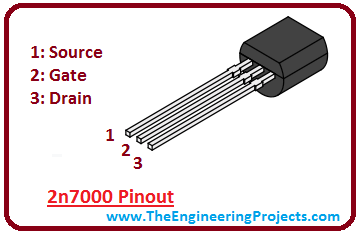
- Gate is practically isolated from drain and source and it draws no current.
- There is an insulation layer that lies between the gate and the body of transistor.
Working of 2n7000
- In 2n7000, the conduction between source and drain is carried out by the movement of electrons.
- In this transistor, source and drain are made up of n-type material while its body and substrate is made up of p-type material.
- In 2n7000, gate is biased by applying the positive input voltage that will attract the electrons available in the p-type semiconductor substrate.
- The gate of this transistor is used composed of layer of poly-silicon.
- When we add Silicon dioxide on the layer of substrate it gives the typical metal oxide semiconductor construction.
- Silicon dioxide is a dielectric material so it will act as a capacitor where one of its electrodes will be replaced by the semiconductor.
- If we apply positive voltage at the MOS structure, it will alter the charge distribution in the semiconductor. With the addition of positive voltage, the holes present under the oxide layer will experience a force and allow the holes to move downward. The depletion region will be accumulated by the bound negative charges which are associated with acceptors atoms.
- The overdose of free electrons available in the p-type substrate increases the overall conductivity of channel, and constantly inverts the electrical properties of p-type substrate, allowing the substrate to change into n-type material.
- The positive voltage applied on the gate terminal control the movement of electrons. As we increase the positive change at the gate terminal the more it will attract the electron, hence resulting in widening the channel path between source and drain terminals. Thus, increasing the positive voltage at the gate terminal will increase the overall conductivity of the transistor.
- This N-Channel transistor is composed to reduce on state resistance and give efficient switching performance.
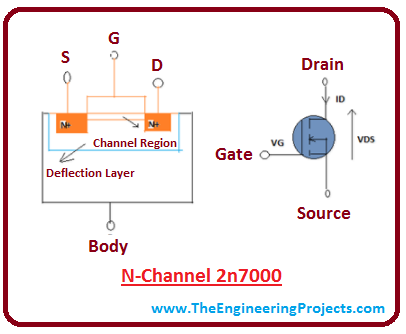
Maximum Rating 2n7000
Maximum rating of 2n7000 are given in the figure given below.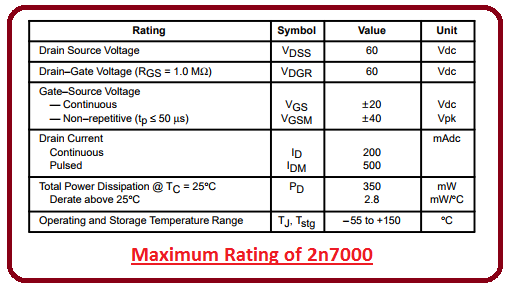
- Drain-Source voltage is 60 V while Drain current is 200 mA.
- Power dissipation is about 350 mW.
- If values are exceeded more than the given values, they can harm the device at large.
Difference between N-Channel MOSFET and BJT
- N-Channel MOSFET are unipolar devices and BJT are bipolar devices.
- BJT are current control devices while MOSFET are voltage controlled devices.
- In BJT, we need base current to control the large amount of current at emitter and collector. In MOSFET, no biasing is required at the gate side as it draws no current. However small initial current is needed to charge the capacitance of the transistor.
Applications
- 2n7000 is mostly used for low power switching applications.
- It is used as a driver for motors, relays and lamps.
- It is widely used in battery operated systems and solid state relays.
- High speed circuits use MOSFET 2n7000 as it requires no buffer.
×
![]()








 1 user
1 user






 Continue Wishlist
Continue Wishlist





 Getting Started Guide
Getting Started Guide
 Help Center
Help Center
 Contact us
Contact us
 Doist Blog
Doist Blog
 Privacy
Privacy
 Security
Security
 Terms of Service
Terms of Service
 What's new: Channel Descriptions
What's new: Channel Descriptions





 Electronic Components
Electronic Components adnanaqeel
adnanaqeel 0 Comments
0 Comments








 2.3k
2.3k
 953
953
 921
921
 2.1K
2.1K
 introduction to 2n7000
intro to 2n7000
working of 2n7000
principle of 2n7000
basics of 2n7000
introduction to 2n7000
intro to 2n7000
working of 2n7000
principle of 2n7000
basics of 2n7000
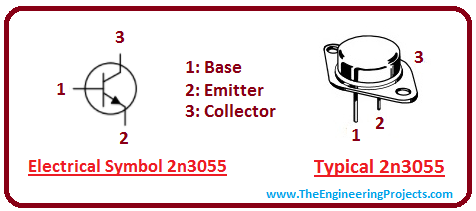
 Saturday, February 24, 2018
Saturday, February 24, 2018
























